4.3 THE MEDIA BED TECHNIQUE
Media-filled bed units are the most popular design for small-scale aquaponics. This method is strongly recommended for most developing regions. These designs are efficient with space, have a relatively low initial cost and are suitable for beginners because of their simplicity. In media bed units, the medium is used to support the roots of the plants and also the same medium functions as a filter, both mechanical and biological. This double function is the main reason why media bed units are the simplest; the following sections demonstrate how NFT and DWC methods both require isolated and more complicated components for filtration.
However, the media bed technique can become unwieldy and relatively expensive at a larger-scale. Media can become clogged if fish stocking densities exceed the beds' carrying capacity, and this can require separate filtration. Water evaporation is higher in media beds with more surface area exposed to the sun. Some media are very heavy.
There are many designs for media beds, and this is probably the most adaptable technique. For example, Bumina is an aquaponic technique used in Indonesia that uses many small media beds connected to an in-ground fish tank (Section 9.4.3). Moreover, recycled materials can easily be repurposed to hold the media and the fish.
4.3.1 Water flow dynamics
Figure 4.50 shows the main components of an aquaponic system using media beds, including the fish tank, the media beds, the sump tank and water pump, as well as concrete blocks for support. It is easiest to understand by following the water flow through the system. Water flows by gravity from the fish tank, through a simple mechanical filter and into the media beds. These media beds are full of porous biofilter media that serves as both the mechanical and biological filter and location for mineralization. These beds both host the colony of nitrifying bacteria as well as provide the place for the plants to grow. On exiting the media beds, the water travels down to the sump tank, again by gravity. At this point, the water is relatively free of solid and dissolved wastes. Finally, this clean water is pumped back to the fish tank, which causes the water level to rise and over-flow from the fish tank back into the media beds, completing the cycle. Some media beds are designed to flood-and-drain, which means that the water level rises to a certain point and then completely drains. This adds oxygen to the plant roots and aids in the biofiltration of the ammonia. Other media irrigation methods use a constant flow of water, either entering one side of the bed and exiting the other, or distributed through a drip irrigation array.
FIGURE 4.50
Illustration of a small media bed unit
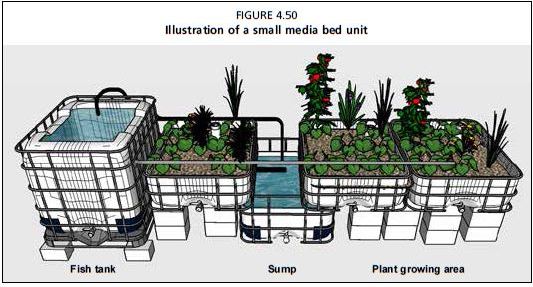
4.3.2 Media bed construction
Materials
Media beds can be made from plastic, fibreglass or a wooden frame with water-tight rubber or polyethylene sheeting on the base and inside the walls. The most popular "do-it-yourself" (DIY) media beds are made from plastic containers, modified IBCs or even old bathtubs (Figure 4.51). It is possible to use all of the above as beds and other kinds of tanks so long as they meet these following requirements:
strong enough to hold water and growing media without breaking;
⚫able to withstand difficult weather
conditions;
made of food-grade material that is safe for
the fish, plants and bacteria;
FIGURE 4.51
Media bed unit constructed from intermediate bulk containers
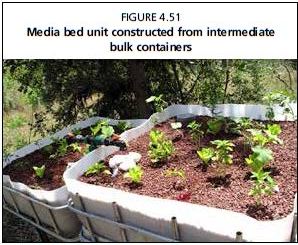
⚫ can be easily connected to other unit components through simple plumbing parts; and
can be placed in close proximity to the other unit components.
Shape
The standard shape for media beds is a rectangle, with a width of about 1 m and a length of 1-3 m. Larger beds can be used/manufactured, but they require additional support (i.e. concrete blocks) in order to hold their weight. In addition, longer beds may have unequal distributions of solids that tend to accumulate at the water inlet, raising the risk of anaerobic spots. The beds should not be so wide that the farmer/ operator is unable to reach across, at least half-way.
Depa
Media bed depth is important because it controls the amount of root space volume in the unit which determines the types of vegetables that can be grown. If growing large fruiting vegetables such as tomatoes, okra or cabbage, the media bed should have a depth of 30 cm, without which the larger vegetables would not have sufficient root space, would experience root matting and nutrient deficiencies, and would probably topple
FIGURE 4.52 Fibreglass tanks used in a media bed unit
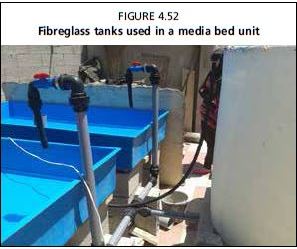
over (Figure 4.52). Small leafy green vegetables only require 15-20 cm of media depth, making them a good choice if the media bed size is limited. Even so, some experiments have shown that even the larger crops can be grown in shallow beds if the nutrient concentrations are sufficient.
4.3.3 Choice of medium
All applicable growing media will have several common and essential criteria. The medium needs to have adequate surface area while remaining permeable for water and air, thus allowing the bacteria to grow, the water to flow and the plants roots to breathe. The medium must be inert, not dusty, and non-toxic, and it must have a neutral pH so as not to affect the water quality. It is important to wash the medium thoroughly before placing it into the beds, particularly volcanic gravel which contains dust and tiny particles. These particles can clog the system and potentially harm the fishes' gills. Finally, it is important to work with material that is comfortable for the farmer. These essential criteria are listed below:
large surface area for bacterial growth;
⚫ neutral pH and inert (meaning the medium will not leach out any potentially toxic substances);
good drainage properties;
easy to work with;
⚫ sufficient space for air and water to flow within the medium;
available and cost-effective; and
⚫ light-weight, if possible.
Several common media meeting the criteria are discussed include:
Volcanic gravel (tuff)
Volcanic gravel is the most popular medium to use for media bed units and is recommended where available (Figure 4.53). The three best qualities of volcanic gravel are that it has a very high surface area to volume ratio, it can be cheap and easy to obtain, and it is almost chemically inert. Volcanic gravel has a surface area to volume
FIGURE 4.53
Volcanic tuff used as growing medium
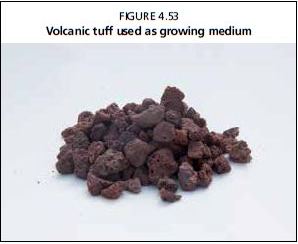
ratio of about 300 m2/m3, depending on the particle size, which provides ample space for bacteria to colonize. Volcanic gravel is abundant in many locations around the world. Once washed of dust and dirt, volcanic gravel is almost completely chemically inert, except for small releases of microelements such as iron and magnesium and the absorption of phosphate and potassium ions within the first few months of starting a unit. The recommended size of volcanic gravel is 8-20 mm in diameter. Smaller gravel is likely to clog with solid waste and larger gravel does not offer the surface area or plant support as required.
Limestone
Limestone is not recommended as a growing medium, though it is commonly used (Figure 4.54). Limestone, a sedimentary rock, is less desirable than other media because it has a lower surface area to volume ratio, is heavy and is not inert. Limestone is composed primarily of calcium carbonate (CaCO3), which dissolves in water and affects water quality. Limestone will increase the KH of the water, which will also increase the pH (see Section 3.3). Therefore, this material is better used where water sources are very low in alkalinity or acidic, as in cases of alkaline water it would call for constant acid corrections of
FIGURE 4.54
Limestone gravel used as growing medium
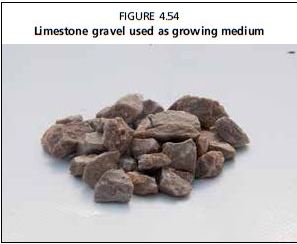
incoming waters. Nevertheless, a small addition of limestone can help to counterbalance the acidifying effect of nitrifying bacteria, which can offset the need for regular water buffering in well balanced systems. Limestone may not be as comfortable to work with in terms of planting and harvesting, and it can experience clogging if the proper granulometry is not chosen. However, it is often the cheapest and most common form of gravel available. Limestone is only acceptable as a medium if no other media are available, but be aware of its impact on water quality.
Light expanded clay aggregate
FIGURE 4.55
Light expanded day aggregate pellets used as growing medium
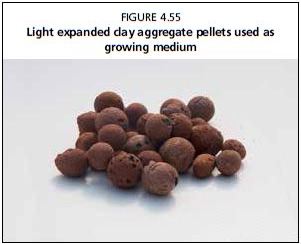
Light expanded clay aggregate (LECA) consists of expanded clay pebbles (Figure 4.55). Originally, it was manufactured for thermal insulation of building roofs, but it has more recently been used in hydroponics. These pebbles are round in shape and very lightweight compared with other substrates. They are very comfortable to work with and ideal for rooftop production. The surface area of LECA is about 250-300 m2/m3, which is within the target range. However, LECA is relatively expensive and not widely available around the world. It comes in a variety of sizes; for aquaponics the larger sizes with diameters 8-20 mm are recommended. This material can give additional benefits to growers in case of media beds placed directly on rooftop floors (depending on design). The building can in fact benefit from additional insulation, which can decrease houses' cooling/heating costs.
Other possible media choices
If the above-listed media are unavailable, it is possible to use other media. Alternatives include: river-bed gravel, which is usually limestone but can have a low surface area to volume ratio depending on the granulometry; pumice (also rockwool), a white/grey volcanic material also popularly used as growing medium in hydroponics; recycled plastic, although plastic floats and needs to be held submerged with a layer of gravel on top; or organic substrates such as coconut fibre, sawdust, peat moss or rice hull, which are often inexpensive but risk becoming anoxic, deteriorating over time and clogging the system. However, organic substrate can be used for a time within aquaponics, and once it begins to deteriorate, the media can be removed from the system, composted, and used as a valuable soil addition for soil crops. Table 4.1 summarizes the major characteristics for all the growing media mentioned above.
TABLE 4.1
Characteristics of different growing media

Displacement of water by media
Depending on the medium, it will occupy roughly 30-60 percent of the total media bed volume. This percentage will help decide on the sump tank size for each unit, because the sump tank, at the very least, will need to hold the total water volume contained in all the media beds. Sump tanks should be slightly oversized to ensure that there is always adequate water for the pump to run without ever running dry.
For example, for a media bed of 1 000 litres (dimensions 2 m long x 2 m wide × 0.25 m medium depth), the growing medium will displace 300-600 litres of this space, and therefore the water volume of the media bed would be 400-700 litres. It is recommended that the sump volume be at least 70 percent of the total media bed volume. For this example, the sump tank should be approximately 700 litres.
4.3.4 Filtration
The media beds serve as very efficient filters, both mechanical and biological. Unlike the NFT and DWC systems (discussed below), the media bed technique utilizes a combination filter and plant growing area. In addition, the media bed provides a place for mineralization to occur, which is absent in the NFT and DWC systems. However, at high stocking densities (>15 kg/m3), the mechanical filtration can be overwhelmed and can face the risk of having the media clogged and producing dangerous anaerobic spots.
Mechanical filter
The medium-filled bed functions as a large physical filter, capturing and containing the solid and suspended fish waste and other floating organic debris. The effectiveness of this filter will depend on the particle size of the medium because smaller particles are more densely packed and capture more solids. Moreover, a high water flow rate can force particles through the media bed and escape the filter. Over time, the captured solid wastes will break down and be mineralized. A properly balanced system will process all of the incoming solid wastes.
When media beds are improperly sized for the stocking density, the media bed can become clogged with solids. This indicates a mistake in the original design when the feed rate ratio was used to balance the system. This situation leads to beds clogged with solid waste, poor water circulation, anoxic areas and dangerous conditions. When this occurs, the medium needs to be washed, which is labour-intensive, disrupts the plant growing cycle and can briefly disturb the nitrifying bacteria.
To avoid this situation be sure that the original design considered the stocking density, feeding regime, and used the feed rate ratio to calculate the required area of the media bed. Alternatively, another solids capture device can be integrated into the unit design. This is also recommended where the stocking density exceeds 15 kg/m3 and/or if the feeding rate is above 50 g/day for each square metre of grow bed. There are several options for this additional mechanical filter. A rudimentary and cheap technique is to affix an old, orphan sock to the tap where water from the fish tank enters the media bed. This simple filter can be removed each day and rinsed. Another more elaborate method is to place a 3-5 litre bucket inside the media bed with several small holes (6-8 mm) drilled into the side surfaces (Figure 4.31). Sponges, nylon netting or even growing media (volcanic gravel, LECA) can be tied in a porous inert net bag and placed into this bucket. This filter will trap the solid waste, and the filter can then be removed periodically to be rinsed and replaced.
Biological filtration
All of the growing media herein outlined have a large surface area where nitrifying bacteria can colonize. Of all of the aquaponic designs, media beds have the most biological filtration because of the huge area of media on which the bacteria can grow. Biofiltration capacity can be limited or lost if the media beds become anoxic, if the temperatures drop or if the water quality is poor, but generally media beds have more than adequate biological filtration.
Mineralization
Over time, the solid and suspended fish waste and all other debris are slowly broken down by biological and physical processes into simple nutrients in the form of simple molecules and ions that the plants can easily absorb. If sludge accumulates in the media bed and does not leave, it may indicate that the mineralization process is not sufficient. In this case, the recommendation is to use more effective mechanical filtration and process the filtered waste separately. This process is described in more detail in Section 4.2.2 and Chapter 5.
4.3.5 The three zones of media beds characteristics and processes
The nature of a flood-and-drain media bed creates three separate zones that can be considered microecosystems, which are differentiated by their water and oxygen content. Each zone hosts a diverse group of bacteria, fungi, micro-organisms, worms, insects and crustaceans. One of the most important is the nitrifying bacteria used for biofiltration, but there are many other species that all have a role in the breaking down of fish wastes. It is not essential to be aware of all these organisms, but this section briefly outlines the differences between these three zones and some of the ecological processes occurring in each.
Dry zone
The top 2-5 cm of the bed is the dry zone (Figure 4.56). This zone functions as a light barrier, preventing the light from hitting the water directly which can lead to algal growth. It also prevents the growth of fungus and harmful bacteria at the base of the plant stem, which can cause collar rot and other plant diseases. Another reason to have a dry zone is to minimize evaporation from beds by covering the wet zone from direct light. Moreover, beneficial bacteria are sensitive to direct sunlight.
Dry/wet zone
This is the zone that has both moisture and high gas exchange. In flood-and-drain techniques (discussed below) this is the 10-20 cm space where the media bed intermittingly floods and drains (Figure 4.57). If not using flood-and-drain techniques, this zone will be the path that the water flows through the medium. Most of the biological activity will occur in this zone. The root development, the beneficial bacteria colonies and beneficial micro-organisms are active in this zone. The plants and the
FIGURE 4.56
The three zones of a media bed during the drain cycle
FIGURE 4.57
The three zones of a media bed during the flood cycle
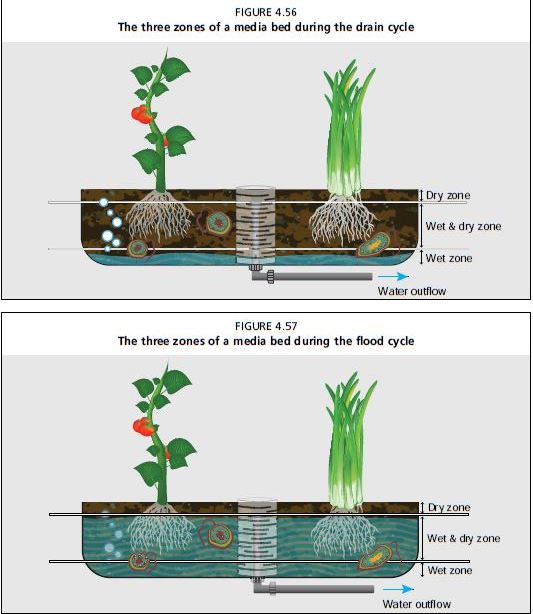
animals receive their water, nutrients and oxygen because of the interface between air and water.
One common technique is adding worms to the media bed which will live in this dry/wet zone. The worms will contribute to the breakdown of solid fish waste and they will also consume any dead leaves or roots. This activity will prevent wastes from clogging the system. See Section 9.1.1 for more information about worms and vermicompost.
Wet zone
This zone, the bottom 3-5 cm of the bed, remains permanently wet. In this zone, the small particulate solid wastes accumulate, and, therefore the organisms that are most active in mineralization are located here. These include heterotrophic bacteria and other micro-organisms. These organisms are responsible for breaking down the waste into smaller fractions and molecules that can be absorbed by the plants through the process of mineralization.
4.3.6 Irrigating media beds
There are different techniques to deliver water to media beds, each can be relevant depending on the local availability of materials, the degree of technology desired or the experience of the operators. Water can be simply trickled from holed pipes uniformly distributed on the medium; this is a perfectly acceptable design. Some experts have demonstrated that constant flow designs, where the water level within the grow bed is always the same, support the same growth rates of plants as more complicated methods. These water distribution systems can become clogged with solid fish waste and should be periodically cleared.
A method called flood-and-drain, also known as ebb-and-flow, can be used where the system of plumbing causes the media beds to flood with water from the fish tank and then drain back in the sump tank. This is accomplished through autosiphons or timed pumping. This alternation between flooding and draining ensures that the plants have both fresh nutrients and adequate air flow in the root zone. This thereby replenishes the oxygen levels for plants and bacteria. It also ensures that enough moisture is in the bed at all times so the bacteria can thrive in their optimum conditions. Usually, these systems go through the complete cycle 1-2 times every hour, but some successful systems only cycle 3-4 times per day. Flood-and-drain designs are not the only techniques for media beds, and managing the water flow cycle may be frustrating and time-consuming for novice operators.
This publication briefly discusses two popular methods for flooding and draining a bed, although other methods, such as the looped siphon, exist and are the subject of current research.
Bell siphon
The bell siphon is a type of autosiphon that exploits afew physical laws of hydrodynamics and allows the media bed to flood and drain automatically, periodically, without a timer (Figure 4.58). The action, timing and ultimate success of the siphon are dependent on the water's flow rate into the bed, which is constant. Bell siphons can nevertheless be finicky and require attention.
FIGURE 4.58
Diagram of a bell siphon and components installed in a grow bed
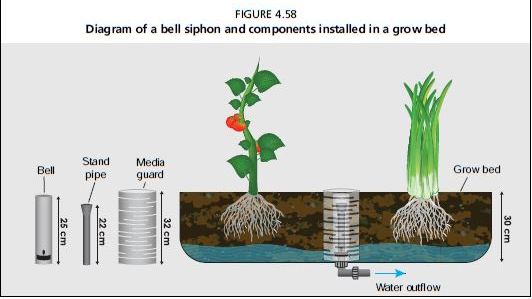
Water flows into each grow bed at a constant flow rate. As the water fills the grow bed it reaches the top of the standpipe, and begins to drip through the standpipe back to the sump tank. Without the bell portion of the bell siphon, this would create a condition
of constant water height. Instead, as the water continues to fall through the standpipe, the bell, which sits over the standpipe something like a hat, acts as an air tight lock and produces a siphon effect. This suction within the bell starts the siphon. Once started, all the water from the bed starts to rapidly flush down the standpipe as the bell keeps its air tight seal. The draining through the standpipe is faster than the constant inflow from the fish tank. When the water in the grow bed drains all the way down to bottom, air enters the bottom of the bell and immediately stops the siphon. The water then slowly fills back up and repeats the whole cycle again continuously. See the section on Further Reading at the end of this publication for more information on bell siphons.
Main components of a bell siphon
The three main components of a bell siphon are described below. Note that detailed instructions for understanding, constructing and optimizing bell siphons, as well as pictures of these components, can be found in Appendix 8. The dimensions of the standpipe, bell and media guard are completely dependent on the size of the grow bed and incoming water flow rate. These dimensions are provided for the aquaponic designs outlined in this publication for a media bed of 1-3 m2 with a media depth of 30 cm, with an incoming water flow rate of 200-500 litres/h for each bed. For large grow beds, all of the components would be larger.
Standpipe - The standpipe is constructed of a PVC pipe, 2.5 cm diameter, of a height of 22 cm. The standpipe passes through the bottom of the grow bed, connecting to the sump, and is the path of the water as it drains.
Bell The bell is a PVC pipe, 7.5 cm diameter, of a height of 25 cm. The pipe is capped with a PVC end-cap on top, and is open on the bottom where it fits over the standpipe. Two rectangular gaps, 1 cm x 4 cm, are located near the bottom of the bell, 1.5 cm up on opposite sides, through which the water is pulled up into the standpipe inside the bell. A final 1 cm hole is drilled 5 cm from the bottom to help break the siphon once the grow bed is drained by allowing air to enter.
Media guard - The media guard is a PVC pipe, 11 cm diameter, of a height of 32 cm with many small holes drilled in its sides. The media guard prevents the gravel from the grow bed from entering and clogging the standpipe, without obstructing the flow of water.
Timer mechanism
This method of flood-and-d rain irrigation relies on a timer switch on the water pump to control the periodic flooding and draining (Figure 4.59). The benefit of this method
FIGURE 4.59
Diagram of a media bed stand pipe and media guard
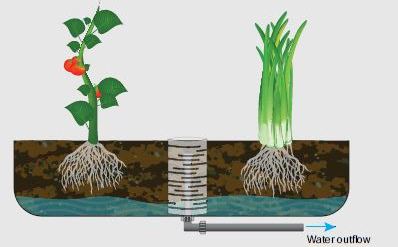
is that there is no autosiphon, which can be labour-intensive to calibrate. However, the reduced water circulation and reduced aeration in the fish tanks results in less overall filtration. This method is less appropriate in high-density stocking situations, and requires careful attention to provide supplemental aeration to fish.
Water flow dynamics
Water flows into the grow bed, flooding the bed until the water reaches the top of the standpipe. The water then drains through this standpipe and down into the sump tank. The large standpipe is of sufficient diameter to drain all of the inflowing water; the top of the large standpipe is the deepest flood that the grow bed will experience. There is also a small inlet, 6-12 mm diameter, into this same standpipe located near the bottom. This small inlet is insufficient to drain all of the incoming water and, therefore, even as water enters the small inlet, the grow bed continues to flood until it reaches the top. At some point after the bed is full, the timer cuts the power to the water pump. Water in the media bed begins to flow out through the small inlet hole, continuing to drain the grow bed until the water reaches the level of the bottom hole. At this point, the power is returned to the water pump and the grow bed is refilled with fresh fish-tank water. It is very important that the water flowing into the media. bed is greater than the water flowing through the small inlet in the standpipe so that the bed will fully flood again. The flooding and draining cycle length and the diameter of the dripping hole are determined by the size of the media bed and the incoming flow rate.
To ensure adequate filtration, the entire fish tank volume should be pumped through the grow beds every hour. Finally, make sure to flush the beds out once every week by temporarily removing the standpipe and allowing the remaining water to drain.
The materials involved for the timer method for the aquaponic designs included in this publication are as follows: a standpipe, 2.5 cm diameter, of a height of 23 cm that has a secondary dripping hole, 6-12 mm diameter, 2.5 cm above the bottom; a media guard, 11 cm diameter and 32 cm in height, encircling the standpipe to prevent media from clogging it; and a timer that controls the pump that is calibrated based on the flow rate of the pump and the drain rate of the standpipe.